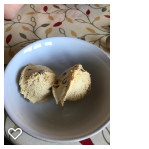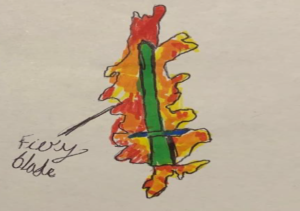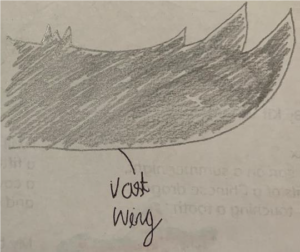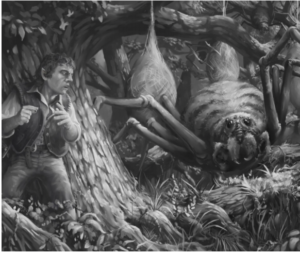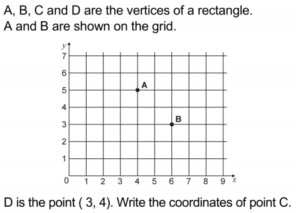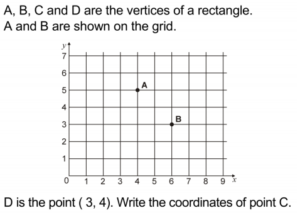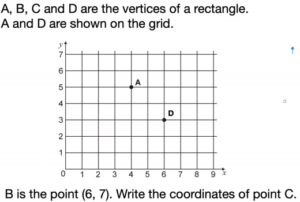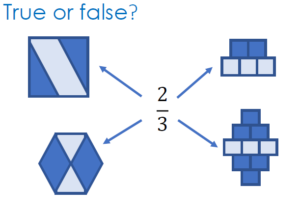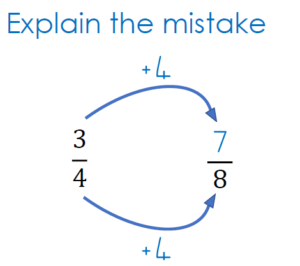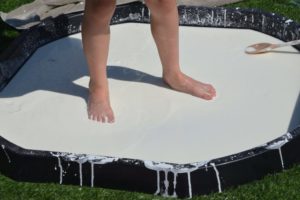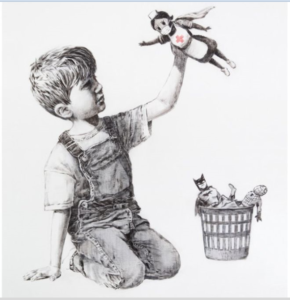A message from Mrs Lavery
Hello everyone!
I’m glad to hear that you’ve been enjoying the sunshine as well as doing your home learning tasks.
I’ve been experimenting and making different flavours of ice cream, my husband and son are very happy when I get the urge to create new flavours.
This is my caramel and choc chip delight!
I’ve been keeping active by doing walks and cycling. Here is a picture of some sheep and their lambs that I passed on my cycle route.
Take care of yourselves and each other.
Mrs Richardson.
Thank you to all of the children who have sent through photos of the work that they have been doing to our class email addresses! We love seeing all that you have done so please keep them coming!
Pupils and parents please remember that reading, writing and maths home learning tasks should be your first focus when completing activities. You may then select the learning activities you wish to complete from all of the other foundation subjects. There is no expectation for pupils to complete every task that we set.
Here are your home learning activities for this week
Reading
Task 1: At least 20 minutes reading every day. Please make sure you are choosing an age appropriate book!
Task 2: Reading Comprehension: The Balrog, by JRR Tolkien
5 day reading sequence
This sequence is developed around an extract from ‘The Fellowship of the Ring,’ by J.R.R. Tolkien. The extract describes the arrival of The Balrog, a monster from underground.
Children will explore the language used for effect.
How to use:
- Read the instructions carefully before you start a task.
- Each sequence contains simple explanations and examples to help you.
How can parents help?
- Read the extracts aloud with your child.
- Check your child understands any new or unfamiliar vocabulary.
- Adapt any of the resources and materials as you feel necessary to support your child’s needs.
Lesson 1: Read and enjoy together
Enjoy reading this challenging and descriptive passage together, both in your head and aloud with expression. Discuss unknown vocabulary and focus on how the use of punctuation affects reading with fluency.
The Balrog
The Balrog: J.R.R. Tolkien
“Something was coming up behind them. What it was could not be seen: it was like a great shadow, in the middle of which was a dark form, of man-shape maybe, yet greater; and a power and terror seemed to be in it and go before it…Its streaming mane kindled and blazed behind it. In its right hand was a blade like a stabbing tongue of fire; in its left it held a whip of many thongs….His enemy halted again, facing him, and the shadows about it reached out like two vast wings. It raised the whip, and the thongs whined and cracked. Fire came from its nostrils.”
Lesson 2: Language for effect
The Balrog: J.R.R. Tolkien
“Something was coming up behind them. What it was could not be seen: it was like a great shadow, in the middle of which was a dark form, of man-shape maybe, yet greater; and a power and terror seemed to be in it and go before it…Its streaming mane kindled and blazed behind it. In its right hand was a blade like a stabbing tongue of fire; in its left it held a whip of many thongs….His enemy halted again, facing him, and the shadows about it reached out like two vast wings. It raised the whip, and the thongs whined and cracked. Fire came from its nostrils.”
Task: Imagine you are the illustrator: which words and phrases would you highlight to help create the illustration which accompanies the extract? (I’ve highlighted 2 above already) This task will help you to understand how authors use language to paint a vivid picture in the reader’s mind.
Lesson 3: Exploring the effect on the reader
Task:
Read the extract once more for pleasure and discuss the words and phrase highlighted yesterday. Transfer the words and phrases that you highlighted yesterday onto a blank table and write the effect this has on you as a reader. Two examples have been modelled below to help you.
| Word or phrase | Effect on reader |
| great shadow | This makes the reader feel that a dark shape is looming behind them |
| blazed | This makes the reader imagine that the Balrog’s mane is on fire.. |
- Get creative!
Draw and label the Balrog (or parts of it) using the vocabulary in the extract. Here’s a few examples:
- Quick quiz
Using the extract, explore these questions and encourage your child to respond using evidence from the text to back up their answers.
1)What is the Balrog carrying?
2)‘Something was coming up behind him…’ Why do you think Tolkien started the description with the word ‘something?’
3)What impression do the words ‘whined’ and ‘cracked’ give you of the way the whip moved through the air?
4)If you were faced with The Balrog, would you be afraid? Use evidence from the text to back up your answer
Writing:
Task 1: Explore the image
Click on the link below and explore the image
https://www.pobble365.com/bilbo-baggins/
Task 2: Question time!
Q1: What is the creature behind the tree?
Q2: What are those large sacks hanging from the branches?
Q3: How do you think Bilbo is feeling?
Q4: What will happen after he puts the ring on his finger?
Task 3: Sentence challenge
Here is the start of a story linked to the picture.
Too afraid to move an inch, Bilbo pressed his back firmly against the ancient oak tree. He could feel his heart thumping frantically inside his chest, as he heard the monster inching gradually ever closer through the undergrowth towards his hiding place. Hands trembling, almost uncontrollably, Bilbo placed the ring on his finger…
1: Can you find all the adverbs in the text?
2: Can you write a sentence starting with an adverb to describe what either Bilbo, or the spider, are doing?
3: Can you then try to use the adverb in a different place in your sentence?
Task 4: Continue the story.
Read the story start again. Your task is to continue the story and you must include the following:
- A range of powerful description including similes, metaphor and personification
- A variety of sentence length including complex sentences and short sentences for effect
- A range of fronted adverbials to start your sentences.
Too afraid to move an inch, Bilbo pressed his back firmly against the ancient oak tree. He could feel his heart thumping frantically inside his chest, as he heard the monster inching gradually ever closer through the undergrowth towards his hiding place. Hands trembling, almost uncontrollably, Bilbo placed the ring on his finger…
Task 5: Perfect picture!
This picture is in black and white. Can you draw the picture of Bilbo and the spider yourself? Think carefully about the colours you will use. The colour you choose might depend upon the time of year it is, or the time of day it is.
Spellings and Grammar:
Task 1: Spelling task on Sumdog.
Task 2: Grammar task on Sumdog.
Task 3: To learn plurals of words ending in ‘o’.
Which of these words ends in ‘s’ and which end in ‘es’?
Can you identify the rule?
| Piano | Tornado | Cello |
| Tomato | Concerto | Potato |
| Hero | Volcano | Memento |
| Video | Radio | zoo |
Maths:
Task 1: 20 minutes of times tables work every day. Use TT Rockstars to help you practise.
Task 2: Arithmetic task and times tables task on Sumdog.
Task 3: There are 2 activities set on My Maths to complete. Use your log in details to get onto the website.
Task 4: Solve the maths problems, involving coordinates –
Plot points on a coordinate grid in the first quadrant.
1:
2:
3:
Challenges:
1: Explain why the shapes do or do not show 2/3.
2: Explain the mistake.
Family Science Activity – Friday 8th May
THE SCIENCE OF OOBLECK
https://www.science-sparks.com/how-to-make-oobleck/
Did you notice that if you make a ball with oobleck or gloop it feels solid, but if you drop the oobleck on the floor it turns liquid again? The slime is a non – Newtonian fluid as it doesn’t flow like liquids normally do.
https://www.youtube.com/watch?v=Fnd-2jetT1w
Cornflour gloop ( oobleck ) is made up of molecules arranged in long chains. When the chains are stretched the liquid will flow, but when you force them together they stick together to form a solid.
OOBLECK RECIPE
- Cornflour
- Water
- Food colouring – optional
- Ice cube trays – optional
- Mixing bowl
- Colander, funnel and beakers – optional, but great for messy fun!
INSTRUCTIONS FOR MAKING CORNFLOUR GLOOP
- Fill a cup with cornflour and add to the bowl
- Add water very slowly mixing with your hands, until you get a sticky, slimy gloop.
- If you want to make it coloured add some food colouring. ( be careful this can stain skin and clothes)
- Play with the slime and see how it behaves. Can you make it into a ball? and what happens if you throw it onto the floor?
- Can you squeeze the slime into a ball? What does it feel like? How long does the ball stay solid after you let go?
- If you used less water do you think the slime would fall faster or more slowly through the colander?
OOBLECK CHALLENGE
Can you make a giant oobleck tray and walk on oobleck?
HOW TO MAKE A GIANT OOBLECK TRAY
To make our giant oobleck tray – pour about 1 kg of cornflour into a large black tray and slowly added water until the consistency was wet, but solid when squeezed.
Topic activity: VE Day – Friday 8th May 2020
This year’s VE Day will be unlike other years, as we’ll have three days to celebrate the historic occasion marking the day, 75 years ago, that Victory in Europe prevailed during the Second World War. Despite the current restrictions, VE Day looks set to be a packed day of events and activities to honour the historical anniversary.
- At 11am, a two-minute national silence will be held to remember the declaration of victory and the end of the Second World War in Europe.
- Between 2.45 and 3.45pm, the first of two special BBC One programmes to mark VE75 will be broadcast, an including extract from Sir Winston Churchill’s victory speech.
- Throughout the afternoon, Britons are encouraged to hold 1940s-style afternoon tea parties at home rather than street parties, including their homemade bunting and recipes from the era.
- The Queen will then address the nation at 9pm, followed by national doorstep rendition of Dame Vera Lynn’s ‘We’ll Meet Again’.
However you and your family commemorate this special day, we would like you to reflect on something you saw, learned or experienced during this day of celebration. For example,
- A photo of an art/ craft activity that you completed linked with VE day and why you chose to do this.
- After watching a programme or video about VE Day – you could write a diary entry or a letter home from a soldier’s viewpoint of how they felt when they knew that the war had ended, where were they and what did they do to celebrate.
- A personal response to a programme or video about VE day – Describe what you watched and how did you feel after watching this programme? Did you learn something you didn’t know before? Why do you think it is important to commemorate this day as a nation?
- A photo of the family tea party that you had in your house to honour this anniversary.
Don’t forget to send anything you are particularly proud of to your class email.
Art Challenge
Who’s YOUR SUPERHERO?
For this week’s Art Challenge I would like you produce some art that is linked to a superhero. Your superhero can be real, such as our key workers, or someone in your family, or a fictional character from a comic, film or your own imagination. It can be a drawing, a figure made from a kitchen roll tube, street art or anything else that you can think of.
I hope this may inspire you:
This new Banksy artwork has appeared at Southampton General Hospital.
It shows a young boy kneeling by a wastepaper basket dressed in dungarees and a T-shirt. He has discarded his Spiderman and Batman model figures in favour of a new favourite action hero – an NHS nurse. The artist left a note for hospital workers, which read: “Thanks for all you’re doing. I hope this brightens the place up a bit, even if it’s only black and white.”
However, if this doesn’t appeal to you then you can still send any other art work to me and I will post that on the Blog too.
Please email your artwork to me:
n.pearson@stpeterswaterlooville.hants.sch.uk
Thank you
Keep creating and keep safe!
Mrs Pearson
RE
As part of your RE learning, we would like you to focus upon the upcoming celebration of Pentecost – this day is celebrated fifty days after Easter Sunday, to remember how the Holy Spirit appeared to the Apostles of Jesus and gave them hope while they were in Jerusalem.
Can you complete ONE of the following activities, to develop your knowledge of this special time in the Liturgical Year?
- Create a religious crossword that includes the following key words and symbols: wind, flame, tongue, Holy Spirit, disciples, Jerusalem. Can you add more of your own? Don’t forget to record your clues!
- Design a celebration card to spread the Good News at Pentecost – could you post it to a friend to spread joy and hope at this difficult time?
- Write a drama script to ‘act out’ the scene of the disciples as Pentecost with your family at home – what happened to the followers of Jesus?
- Make 10 quiz questions about the Pentecost story. Could you ask a friend or family member about them when you next chat on the webcam/internet, or over the phone?
- Imagine you are a news reporter who has been sent to Jerusalem to find out more about the events that took place at Pentecost. Which 5W questions (who, what, where, when, why) would you ask the disciples?
- Build a model of one of the following Pentecost symbols (flame, wind, speaking in tongues, Holy Spirit) to put on display and remind you that Jesus is near. Which resources could you use from home? Plasticine, recycled plastic, painted cardboard?
- Research the story of Pentecost on the internet, from a Biblical website. Can you draw a thought bubble and record how the feelings of the disciples changed throughout the story?
Music
George Gershwin
Go to the website below and watch Radzi Chinyanganya’s video about George Gershwin.
https://www.bbc.co.uk/teach/ten-pieces/classical-music-george-gershwin-rhapsody-in-blue/zkcy6v4
Why is Gershwin considered to be a musical trailblazer?
Now listen to the whole piece in the second video and create a cityscape as you listen.
